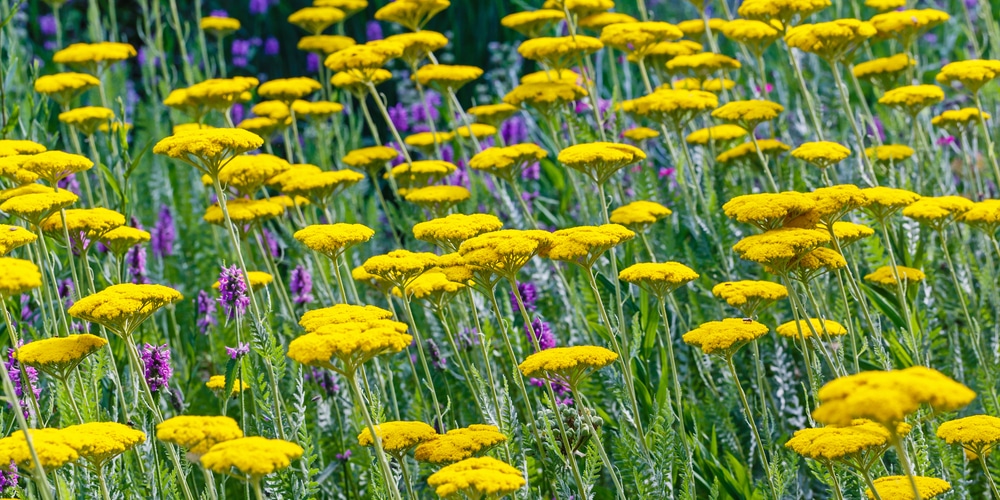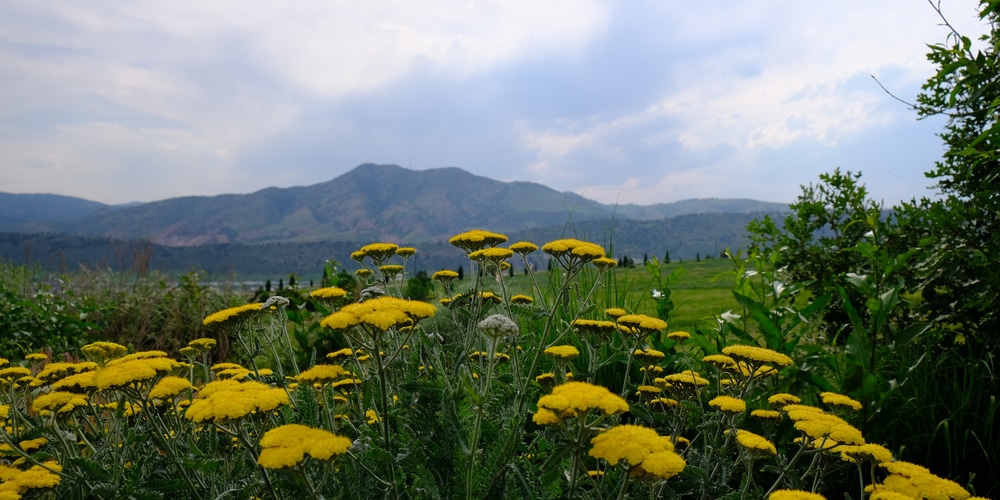If you’re looking for a plant that will add some serious wow factor to your garden, look no further than Achiliea filipendulina. Also known as gold plate yarrow, this tough and easy-to-grow plant produces flat clusters of bright yellow flowers that are simply irresistible!
A native of Europe, Achillea filipendulina is a member of the Asteraceae family and is related to other well-known garden plants such as daisies, sunflowers, and chrysanthemums. This perennial herbaceous plant is often found and used as borders, mass plantings, or as a dried flower.
| Botanical Name | Achillea Filipendulina |
| Common Name | Yarrow ‘Gold Plate’ |
| Plant Type | Perennial |
| Flower Color | Plate-like bright yellow flower heads |
| Size When Mature | 60 inches tall |
| Bloom Time | Early Spring |
| Sun Requirements | Full sun |
| USDA Hardiness Zones | 3 – 8 |
| Soil PH Range | 5.0 – 5.8 |
| Soil Type | Dry, acidic, well-draining soil |
| Water Needs | Low to Medium |
| Native Area | Southwestern and Central Asia |
What You Need to Know About Achiliea Filipendulina
Who can resist the boasting mustard-yellow blooms of Achillea filipendulina? This herbaceous perennial is a welcome sight in the garden, with flowers showing and blooming from early summer until the first frost. The flat-topped clusters of flowers, also known as corymbs, are a magnet for bees and other pollinators.
The flowers float atop a sea of fern-like, gray-green leaves that are deeply divided into thread-like segments. The foliage has a strong fragrance that some people find unpleasant. However, the fragrance is not overpowering and should not deter you from growing this plant.
Friendly to pollinators like butterflies and bees, Achillea filipendulina is a great choice for environmentally-conscious gardeners. It is also deer resistant, drought-tolerant, and relatively low maintenance. Deadheading spent flowers will encourage the plant to produce even more blooms. But don’t worry – pruning this plant is only done if it becomes unruly or overgrown.
How to Care for Achiliea Filipendulina
Here’s everything you need to know about growing and caring for a thriving Achillea filipendulina plant:
Light
Similar to its golden yellow flowers, Achillea filipendulina prefers full sun. This plant will grow and bloom best in an area that receives at least 6 hours of direct sunlight per day. However, it will tolerate partial shade, especially in hot summer climates.
In colder climates, some morning sun is beneficial to help the plant dry out and prevent frost damage.
Water and Soil Needs
This impressive flowering plant doesn’t require much water to thrive. Too much watering can actually lead to fungal diseases. When grown in well-draining soil, Achillea filipendulina is quite drought-tolerant. Remember to touch the soil before watering to see if it is dry.
This plant is not picky when it comes to soil, although it’s best to avoid heavy clay, fertile-rich or soggy soils. It does well in slightly acidic soil between 5.0 to 5.8.
Temperature Requirements
Achillea filipendulina is a tough plant that can tolerate a wide range of temperatures. It is winter hardy in USDA Zones 3 to 8 and can even withstand brief periods of drought. This plant will die back in colder climates but will regrow when the weather warms up.
Fertilizer
Achillea filipendulina is not a heavy feeder, so it doesn’t require much fertilizer. In fact, too much fertilizer can actually result in fewer flowers. A light application of an all-purpose fertilizer once a month is all that is needed.
Common Diseases
Tough and easy to grow, Achillea filipendulina is relatively disease-free. However, there are a few fungal diseases that can affect this plant, such as powdery mildew, rust, and leaf spot.
Preventing and treating these diseases is relatively easy. Be sure to space plants properly to improve air circulation and avoid getting the foliage wet when watering. If you notice any symptoms, remove affected leaves and dispose of them properly.
Aphids, Japanese beetles, and caterpillars may also feed on the foliage. These pests can be controlled with insecticidal soap or other organic methods.
Achiliea Filipendulina Propagation
Despite its regal appearance, Achillea filipendulina is relatively easy to propagate. The best way to propagate this plant is by division, which you should do in early spring before new growth begins.
Dig it up and carefully separate the roots into smaller sections to divide the plant. Each section should have at least one bud or shoot. Carefully inspect the roots and discard any that are damaged or diseased.
Plant the divisions in well-draining soil, water them thoroughly and wait for new growth to appear. Within a few weeks, you should see fresh leaves and flowers.
Related Article: Achillea Terracotta


